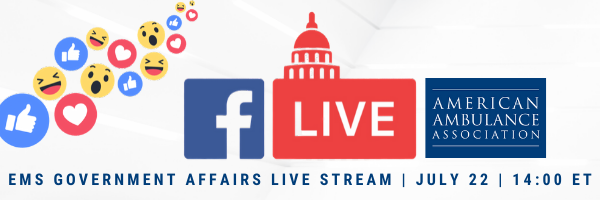Updated CMS FAQs on the Ambulance Data Collection System and Reporting Requirement Delay
As we recently reported, CMS announced that it will be delaying the implementation of the statutorily mandated ambulance data collection system. CMS has released a new set of Frequently Asked Questions (FAQs) clarifying the delay. In sum, ambulance organizations selected to provide cost data for 2020 will now be required to report 2021 data in Year 2. CMS will also add a new set of ambulance organizations for Year 2 reporting as well. This means that twice as many ambulance organizations will be reporting 2021 data in Year 2 and there will be no data reported for 2020. Any organization selected that does not report data will be subject to the 10 percent penalty, unless an exception applies. In addition to addressing concerns about reporting during the pandemic, the FAQs suggest that CMS is concerned that 2020 data “may not be reflective of typical costs and revenue associated with providing ground ambulance services.”
The complete list of these questions, as well as previous ambulance FAQs for COVID-19 on Medicare Fee-for-Service (FFS) Billing can be found here. The new data collections are below.
Data Collection and Reporting Requirements for the Medicare Ground Ambulance Data Collection System
1. Question: CMS requires selected ground ambulance organizations to collect cost, revenue, utilization, and other information through the Medicare Ground Ambulance Data Collection System. The collected information will be provided to MedPAC, which is required to submit a report to Congress on the adequacy of Medicare payment rates for ground ambulance services and geographic variations in the cost of furnishing such services. Will the data collection and reporting requirements for the Medicare Ground Ambulance Data Collection System be delayed due to COVID-19?
Answer: Yes. CMS has issued a blanket waiver: https://www.cms.gov/files/document/summary-covid-19-emergency-declaration- waivers.pdf due to the PHE for the COVID-19 pandemic. CMS is modifying the data collection period and data reporting period, as defined at 42 CFR §414.626(a), for ground ambulance organizations that were selected by CMS to collect data beginning between January 1, 2020, and December 31, 2020 (Year 1).
Under this modification, these ground ambulance organizations can select a new data collection period that begins between January 1, 2021, and December 31, 2021; collect the necessary data during their selected data collection period; and submit the data during the data reporting period that corresponds to their selected data collection period.
CMS is modifying this data collection and reporting period to increase flexibilities for ground ambulance organizations that would otherwise be required to collect data in 2020–2021 so that they can focus on their operations in support of patient care.
As a result of this modification, ground ambulance organizations selected for year 1 data collection and reporting will collect and report data during the same period of time that will apply to ground ambulance organizations selected by CMS under §414.626(c) to collect data beginning between January 1, 2021, and December 31, 2021 (year 2) for purposes of complying with the data reporting requirements described at §414.626.
For additional information on the Medicare Ground Ambulance Data Collection System, please visit the Ambulances Services Center website at
https://www.cms.gov/Center/Provider-Type/Ambulances-Services-Center.
New: 6/16/20
2. Question: Will the 10 percent payment reduction still apply to ground ambulance organizations that are now required to collect and report data under the modified data collection and reporting period but do not sufficiently report the required data?
Answer: Yes. The 10 percent payment reduction described at 42 CFR §414.610(c)(9) will still apply if a ground ambulance organization is selected to collect and report data under the modified data collection and reporting timeframe, but does not sufficiently submit the required data according to the modified timeframe and is not granted a hardship exemption. The payment reduction will be applied to payments made under the Medicare Part B Ambulance Fee Schedule for services furnished during the calendar year that begins following the date that CMS provides written notification that the ground ambulance organization did not submit the required data.
New: 6/16/20
3. Question: The modification states that the ground ambulance organizations that were selected by CMS to collect data beginning between January 1, 2020, and December 31, 2020 (year 1) can select a new continuous 12-month data collection period that begins between January 1, 2021, and December 31, 2021. Do the ground ambulance organizations that were selected in year 1 have an option to continue with their current data collection period that started in early 2020 or choose to select a new data collection period starting in 2021?
Answer: No. The ground ambulance organizations that were selected for year 1 do not have an option and must select a new data collection period that begins in 2021. CMS cannot permit this option because the data collected in 2020 during the PHE may not be reflective of typical costs and revenue associated with providing ground ambulance services. New: 6/16/20
4. Question: Does the guidance mean that there will be no data reporting in 2021 and that both the ground ambulance organizations that were selected for year 1 and the ground ambulance organizations that will be selected for year 2 will collect and report data during the same time periods?
Answer: Yes. Under the modification, ground ambulance organizations that are selected for year 1 will not collect data in 2020. These ground ambulance organizations will select a new data collection period that begins in 2021 and must submit a completed Medicare Ground Ambulance Data Collection Instrument during the data reporting period that corresponds to their selected data collection period. As a result of the modification, year 1 and year 2 selected ground ambulance organizations will collect and report data during the same time periods. New: 6/16/20















